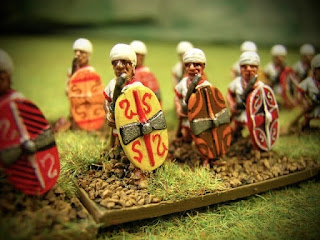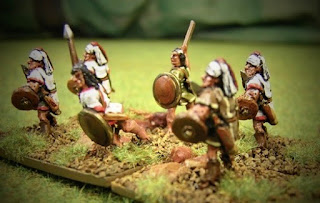Here we delve into the history of what is far and away the ancient empire that excites and interests me most and has done for nearly 50 years.
As the title suggests, we are looking at an overview of the early Achaemenid Persian army and where the famous Immortals fit into the picture. I’ve spread the article over three posts.
 |
| The Immortals ready for battle |
(This post is mainly illustrated with pictures of my recently refurbished DBA 60abc, Early Achaemenid Persian army - more of which may be found here.)
Imperial Achaemenid Forces
The Immortals of Achaemenid Persia are arguably the most romantic of the ancient world’s elite military units. As described by Herodotus, “every man glittered with the gold which he carried about his person in unlimited quantity. They were accompanied, moreover, by covered carriages full of their women and servants, all elaborately fitted out.
Special food, separate from that of the rest of the army, was brought along for them.” The Immortals were always kept at
10 000 strong, they were the Persian heroes at Thermopylae and it ultimately took the famous Spartans hoplites to defeat them at Plataea.
Herodotus is the only ancient source to mention the Immortals in the context of Xerxes’ invasion of Greece. So, who were these legends of the ancient world and how did they fit into the Achaemenid army?
Please note:
This article refers to Persian and Greek forces of the Graeco/Persian wars up to the defeat of Xerxes invasion. This means that the core Persian/Immortal infantry tactic was to form up with a front rank of Sparabara who created a wall of large wicker shields backed up by some ranks of archers and spearmen.
As an interesting aside, while the Greeks characterised their conflicts with the Persians as the battle between the spear and the bow, Achaemenid iconography, in the form of wall friezes cylinders and seals, decidedly emphasises infantrymen with spears over bowmen.
 |
| Iranian infantry in formation |
Unfortunately, the Persians don’t help us with this task as they had no literary tradition in the style of the Greeks. Therefore, most of our written sources, such as Herodotus, are Greek and their inbuilt anti-Persian biases and misunderstandings need to be navigated carefully. Culturally and ideologically the Greeks and Persians were worlds apart. These sources of course aren’t to be discounted, just treated with care.
To start with, it must emphasised that the more militarised Spartans aside, Greek soldiers at the time of the Persian invasion were amateurs; they received no training and could perform only the most basic battlefield manoeuvres [Click here for more on Hoplite Warfare and Spartan Invincibility].
Their line was not so much a coordinated formation of heavy infantry as it was a crowd of warriors. Individual or small regional coalitions of city states prosecuted wars as local political needs demanded. The Greek war experience at this time did not require professional armies or training. The Achaemenids on the other hand, had an empire to run.
 |
| Some Greek hoplites |
The Achaemenid Persian empire can be characterised as a set of concentric circles centred around the King of Kings. The closer a nation was to the Persian heartland, the more it shared in the benefits of the empire, for example by paying less tribute (or in the case of the Persians themselves, perhaps paying no tax) but with increasing responsibilities including contributing more militarily.
Therefore, the Persians, Medes and closely related Iranian peoples received both the greatest benefits and bore the greatest responsibilities of Empire.
So, what constituted Persian Imperial forces?
All Iranian men owed compulsory military service as a foot soldier or as a rider for four years from the age of twenty and remained liable for military call up until he was fifty. Iranian youths faced arduous training in companies of fifty. Training included getting accustomed to standing at watch, archery, throwing the spear and javelin, and of sustaining forced marches in unfriendly climate.
This training led to the development of a Persian military elite, including, according to Professor A. Sh. Shahbaz, specialist heavy infantry led by a developed officer hierarchy.
The Persian army (or spada ) was organised using a decimal system in the following fashion:
- Companies of ten men under a daθapati
- Battalions of ten companies under a θatapati
- Divisions of ten battalions under a hazarapati
- Corps of ten divisions under a baivarapati
The army was led by a supreme commander (spadapati or karana), who was either the King of Kings himself or a trusted close relative or friend.
 |
| A Persian Spadapati or General |
How exactly the Achaemenids recruited their military forces is not well documented, however evidence may be taken with some confidence from Persian bureaucracy records. Thankfully, bureaucratic inclinations in the Persian Empire were highly developed. The general conclusions drawn from these sources can be applied to the wider Persian Empire, differing from area to area more in scale than manner.
There appear to be two strands of military obligation. Firstly, there was an annual silver tax on virtually all estates, large and small, in the empire. These included various land-grants such as Babylonian bow-fiefs, various garrisons, and concentrations of Iranian settlers and 'military colonists' all of whom were obliged to pay this tax to 'serve the king', thus providing money for the outfitting of a soldier. This begins to tell the story of who the Immortals were, but more on that later.
Secondly, was the right of the king to call for additional actual supply of soldiers, equipment and provisions for Royal service, called ilku. This right seems to be exercised fairly rarely, probably for a mobilisation for campaigning and in times of crisis (which could reflect the King's increasing reliance by the later fifth century, upon mercenary service paid for by taxation).
For instance, one set of texts shows an agreement between two joint-fief holders in which one of them would actually go as a cavalryman to Uruk, while the other would provide equipment and one mina of silver for provisions.
 |
| Troops might be levied from across the Empire |
Despite these obligations, it must be understood that the Achaemenid Persians did not run a militarised empire in the style of the Imperial Roman army that had standing armies positioned ready to deal with any military exigencies (or indeed to march on Rome under the command of some usurper).
There were many Iranian garrisons in important centres of the empire, and Satraps and governors also had their guards and local levies, but these could not be depleted to form an army on short notice because the danger of revolt was always present.
In fact, evidence indicates that Satrapal governors had relatively small military forces at their call. Such forces embedded in a province, whether ethnically Iranian or mercenary, generally struggled to repress disorder of the sort that went beyond brigandage or the settling of local disputes.
 |
| Satrapal Armenian infantry |
Satraps were expected to finance local military campaigns themselves, although the Great King might provide some resources. Success or otherwise certainly affected a Satrap’s prestige (though rarely it seems, length of life). Serious rebellions, such as Egypt in c. 460 BCE, had to be dealt with by sending forces from the Imperial heartland.
 |
| Some baggage on the march |
The Persian war machine was highly organised if inclined to be ponderous. It took a long time to muster a grand army (or perhaps it just had to take a long time to move a large force from the centre of the empire to its west). Achaemenid campaigning forces were marshalled from around the empire as required, with campaigns usually starting in early spring. Provisions were stored at various magazines along the route of the march, and were also brought with the army in baggage-trains.
While the size of the Imperial army, be that in times of peace or geared up for a major campaign such as Xerxes’ invasion of Greece, was never as large as the Greeks suggested, it was built around a core of professional soldiers who were trained, battle-hardened and had every reason to be confident of its abilities.
A good model of the Persian military in the field can be found in the major campaigns of the Persians against the Greeks as described by Herodotus. Achaemenid forces were built around a core of Persian troops, both foot and mounted, supported by various other contingents drawn as required from the empire. Invariably, this Persian core performs the best.
For instance, at Marathon the struggle was long and drawn out. The centre was held by the Persians and the Sacae, and was successful, the wings, whose nationalities are not named but are presumably lesser quality levy troops, defeated.
So, larger campaigns conducted by the Persians were highly organised and centred around a core of Persian/Iranian troops. This brings us closer to the Immortals.
Part 2 of this article looks more closely at the psychology of the Achaemenid Persian empire and how the nomadic nature of the Achaemenid Imperial court affected the Persian military system.
Part 1 Part 2 Part 3
Further Reading
Immortals and Apple Bearers: Towards a better Understanding of Achaemenid Infantry Units. - Charles, Michael B
King of the Seven Climes - Lloyd Llewellyn-Jones
King and Court in Ancient Persia 559 to 331 BCE - Lloyd Llewellyn-Jones
https://www.livius.org/articles/concept/immortals/
The Achaemenid Army - Professor A. Sh. Shahbaz
The Administration of the Achaemenid Empire - Christopher Tuplin
The Military Dimension of Hellenistic Kingship. An Achaemenid Inheritance? - Christopher Tuplin
The Persian Military Establishment in Western Anatolia: A Context for Celaenae - Christopher Tuplin
War and Peace in Achaemenid Imperial Ideology - Christopher Tuplin
‘Neither the Less Valorous Nor the Weaker’ Persian military might and the battle of Plataia - Franz Steiner Verlag

























































